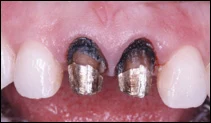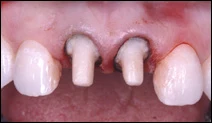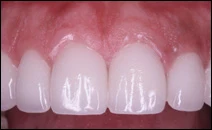Cosmetic Post in Root Canals
Why would root-canal treated teeth need a cosmetic (tooth-colored) post?
All-porcelain restorations allow direct light to penetrate. The amount of scattering versus transmission of light depends on the chemical composition of the porcelain1s glass matrix, the size and structure of the crystalline phase, and the processing technique. Light penetration adds a translucency to the restorations that is comparable to natural teeth even under compromised light conditions. The transillumination quality also improves the natural pale-pink appearance of the adjacent marginal gingiva. The remaining tooth structure should be observed more critically in light of the high translucency of all-porcelain crown systems. Dark and non-pleasing stumps can spoil the appearance of very translucent restorations. The drawback of any light-inhibiting core material is a shadow effect at the gumline. Even all-porcelain crowns can cause a dark gumline if their cores are too opaque and inhibit light transmission. Bleaching, opaquers, and cosmetic endodontic posts should therefore be considered.
What is a cosmetic post?
Cosmetic posts are white and consist of glass fibers or zirconia, which is a dioxide of zirconium. The same material is used for the production of imitation diamonds. The zirconia used for endodontic posts is stabilized with yttrium oxide and exhibits superior fracture toughness and strength. Since the late eighties, the yttrium-oxide stabilized zirconia has been used in orthopaedics for total hip replacement. It has since been improved for dental implants and endodontic posts. Cosmetic posts allow the placement of tooth-colored, metal-free, and translucent restorations. However, zirconium posts require a special surface treatment in order to achieve a strong and permanent bond to the tooth. They are sandblasted with aluminum oxide, silanated, and cemented with a phosphate-monomer modified resin composite. Only this surface treatment allows a durable bond of the post to the tooth. If the wrong cement is utilized, the initial bond between the tooth and the post will eventually decrease.



Cosmetic fiber-post systems
Fiber posts are constructed from unidirectional, pretensed, quartz fibers that are embedded in a resin matrix. This composition leads to a flexural strength that exceeds that of metal posts. However, the modulus of elasticity is very close to that of dentin. The low modulus dissipates stress, as opposed to concentrating stress to prepared root structures (which is observed with pre-formed metal posts). Due to their translucency, fiber posts transmit more light than zirconia posts. They can be intimately bonded to the inner walls of the root canals, while their passive double taper respects natural morphology and allows for a more conservative shaping of the root canal, leaving more healthy tooth structure to support the system.
Despite their strength and integrity, cosmetic fiber-post systems are easily removed, which is almost impossible with zirconia posts.
Cosmetic fiber posts come in various sizes to accommodate the widths of the root canals. Drills and posts are color-coded to ensure exact sizing for the respective post. The cosmetic dentist should ensure to follow the bonding procedure meticulously. Fiber posts should not be handled with bare fingers, since the oils of the skin will interfere with the bonding strength.
Bisco recommends specific bonding agents and cements for the bonding of their D.T. Light-Post System. Their posts are recommended to be coated with One-Step/One-Step-Plus and light cure for 10 seconds, or with 2 coats of All-Bond 2 Primer B and lightly air dry. Bisco recommends Duolink Cement for their system. However, other dual cements, such as Panavia F, would work as well with proper priming. Please note that this information is only an orientation for a patient to get a better idea about cosmetic dental techniques. It is not, in any way, meant to serve as instructions for use for a cosmetic dentist. The dental professional should refer to the official data sheet from Bisco for Instructions for Use and Material Safety.


